Data-Driven Chance-Constrained Schedule Optimization of Cascaded Hydropower and Photovoltaic Complementary Generation Systems for Shaving Peak Loads
Abstract
:1. Introduction
- (1)
- A unit-based peak-shaving schedule optimization model for CHPSs considering transmission capacity is established in this paper. The proposed model considers the peak-shaving demand of the receiving-end power grid and the accommodation of PV power generation.
- (2)
- Non-parametric kernel density estimation is utilized to simulate probability density functions of PV forecast errors based on historical sampling data. To facilitate the modeling of PV uncertainties, the proposed schedule-optimization model is reformulated as a chance-constrained optimization. In addition, the proposed nonlinear model is transformed into a mixed-integer linear programming (MILP) problem to improve computational efficiency.
2. Day-Ahead Peak-Shaving Coordination for Cascade Hydropower and Photovoltaic Systems
- (1)
- In the day-ahead stage, runoff data and photovoltaic outputs on the next day are predicted and reported to the centralized control center of CHPSs.
- (2)
- According to the forecast load data on the next day, the control center of CHPSs makes the unit commitment, stop, and generation plan of CHPSs, with the technical characteristics of cascaded hydropower such as water balance, power capacity, and start-up and shut-down operation constraints taken into account. The power output schedule of CHPSs is then submitted and reported to the system operator of the receiving-end system operator before the power delivery begins.
- (3)
- The system operator of the receiving-end power grids coordinates the power supply and loads of the whole power system to determine the final power generation curve of CHPSs. According to the confirmed transmission plan of CHPSs, the receiving-end system operator then arranges the generation plan for other power plants.
3. Optimal Scheduling Model of CHPSs
3.1. Objective
3.2. Constraints
- Water balance constraints:
- 2.
- Storage control constraints:
- 3.
- Power and abandoned water flow constraints:
- 4.
- Hydropower unit generation characteristic constraints:
- 5.
- Vibration zone restriction of hydropower unit constraints:
- 6.
- Unit commitment constraints:
- 7.
- Generating head of the unit constraints:
- 8.
- Relation between forebay water level and reservoir storage capacity:
- 9.
- Tail water–discharge relationship constraints:
- 10.
- Delivery transmission capacity constraints:
- 11.
- Positive and negative system reserve constraints:
4. Chance-Constrained Model Formulation and Deterministic Transformation
4.1. Modeling of PV Output Uncertainty Sets
4.2. MILP-Based Formulation
4.2.1. Transformation of the Objective Function
4.2.2. Transformation of Power Transmission Limits
4.2.3. Linearization of Output Characteristics of Hydropower Units
4.2.4. Linearization of Vibration Zone Operation Constraints
4.2.5. The Relationship between Forebay Water Level and Storage Capacity
4.2.6. Linearization of the Relationship between Tail Water Level and Release Flow
5. Case Study
5.1. Analysis of the Results of Pre-Day Peak Scheduling
5.2. Comparison between Chance-Constrained Model and Deterministic Model
5.3. Sensitive Analysis of Delivery Transmission Capacity
- Case 1: delivery transmission capacity is 3500 MW;
- Case 2: delivery transmission capacity limits are not considered.
6. Conclusions
- By optimizing the power-generation schedule of cascaded hydropower stations, the fluctuation of photovoltaic power generation can be effectively compensated for, and the peak-shaving goal can be achieved. The output plan for cascaded hydropower is reasonable, with all the hydraulic and unit operation constraints satisfied.
- By fitting the PV forecast error with kernel density estimation, uncertainties of PV power outputs are included to formulate a chance-constrained optimization model for coordinating cascaded hydropower plants and PV stations. Using linear and deterministic transformations, the proposed chance-constrained model can be quickly solved by commercial software.
- The joint operation of hydropower and PV can effectively reduce the negative impact of PV power uncertainties on PV generation curtailment and peak-shaving capacity of CHPSs. That is, PV power curtailment is minimized while the demand for receiving-end power grids’ peak-shaving is satisfied.
Author Contributions
Funding
Institutional Review Board Statement
Informed Consent Statement
Data Availability Statement
Conflicts of Interest
References
- Wang, C.; Hou, Y.; Qiu, F.; Lei, S.; Liu, K. Resilience enhancement with sequentially proactive operation strategies. IEEE Trans. Power Syst. 2017, 32, 2847–2857. [Google Scholar] [CrossRef]
- Zhang, Y.Q.; Zang, W.; Zheng, J.H.; Cappietti, L.; Zhang, J.S.; Zheng, Y.; Fernandez-Rodriguez, E. The influence of waves propagating with the current on the wake of a tidal stream turbine. Appl. Energy 2021, 290, 116729. [Google Scholar] [CrossRef]
- Wang, C.; Ju, P.; Lei, S.; Wang, Z.; Wu, F.; Hou, Y. Markov decision process-based resilience enhancement for distribution systems: An approximate dynamic programming approach. IEEE Trans. Smart Grid 2020, 11, 2498–2510. [Google Scholar] [CrossRef]
- Zhang, Y.Q.; Zhang, Z.; Zheng, J.H.; Zheng, Y.; Zhang, J.S.; Liu, Z.Q.; Fernandez-Rodriguez, E. Research of the array spacing effect on wake interaction of tidal stream turbines. Ocean Eng. 2023, 276, 114227. [Google Scholar] [CrossRef]
- Daneshvar, M.; Mohammadi-Ivatloo, B.; Abapour, M.; Asadi, S.; Khanjani, R. Distributionally robust chance-constrained transactive energy framework for coupled electrical and gas microgrids. IEEE Trans. Ind. Electron. 2021, 68, 347–357. [Google Scholar] [CrossRef]
- Wang, Z.Z.; Wu, F.; Li, Y.; Li, J.Y.; Liu, Y.; Liu, W.E. Day-ahead dispatch approach for cascaded hydropower-photovoltaic complementary system based on two-stage robust optimization. Energy 2023, 265, 126145. [Google Scholar] [CrossRef]
- Wang, Z.Z.; Wu, F.; Li, Y.; Shi, L.J.; Lee, K.Y.; Wu, J.W. Itô-theory-based multi-time scale dispatch approach for cascade hydropower-photovoltaic complementary system. Renew. Energy 2023, 202, 127–142. [Google Scholar] [CrossRef]
- Avesani, D.; Galletti, A.; Piccolroaz, S.; Bellin, A.; Majone, B. A dual-layer MPI continuous large-scale hydrological model including human systems. Environ. Modell. Softw. 2021, 139, 105003. [Google Scholar] [CrossRef]
- Anghileri, D.; Botter, M.; Castelletti, A.; Weigt, H.; Burlando, P. A comparative assessment of the impact of climate change and energy policies on alpine hydropower. Water Resour. Res. 2018, 54, 9144–9161. [Google Scholar] [CrossRef]
- YoosefDoost, A.; Lubitz, W.D. Archimedes screw turbines: A sustainable development solution for green and renewable energy generation—A review of potential and design procedures. Sustainability 2020, 12, 7352. [Google Scholar] [CrossRef]
- Zhang, Z.; Wu, X.; Liao, S.; Cheng, C. A ultra-short-term scheduling model for cascade hydropower regulated by multilevel dispatch centers suppressing wind power volatility. Int. J. Electric. Power Energy Syst. 2022, 134, 107467. [Google Scholar] [CrossRef]
- Javed, M.S.; Ma, T.; Jurasz, J.; Amin, M.Y. Solar and wind power generation systems with pumped hydro storage: Review and future perspectives. Renew. Energy 2020, 148, 176–192. [Google Scholar] [CrossRef]
- Irshad, A.S.; Samadi, W.K.; Fazli, A.M.; Noori, A.G.; Amin, A.S.; Zakir, M.N.; Bakhtyal, I.A.; Karimi, B.A.; Ludin, G.A.; Senjyu, T. Resilience and reliable integration of PV-wind and hydropower based 100% hybrid renewable energy system without any energy storage system for inaccessible area electrification. Energy 2023, 282, 128823. [Google Scholar] [CrossRef]
- Li, F.; Qiu, J. Multi-objective optimization for integrated hydro-photovoltaic power system. Appl. Energy 2016, 167, 377–384. [Google Scholar] [CrossRef]
- Silvério, N.M.; Barros, R.M.; Filho, G.L.T.; Redón-Santaf, M.; Santos, I.F.S.D.; Valério, V.E.D.M. Use of floating PV plants for coordinated operation with hydropower plants: Case study of the hydroelectric plants of the São Francisco River basin. Energy Convers. Manage. 2018, 171, 339–349. [Google Scholar] [CrossRef]
- Guo, S.; Zheng, K.; He, Y.; Kurban, A. The artificial intelligence-assisted short-term optimal scheduling of a cascade hydro-photovoltaic complementary system with hybrid time steps. Renew. Energy 2023, 202, 1169–1189. [Google Scholar] [CrossRef]
- Fagerström, J.; Das, S.; Klyve, Ø.S.; Olkkonen, V.; Marstein, E.S. Profitability of battery storage in hybrid hydropower–solar photovoltaic plants. J. Energy Storage 2024, 77, 109827. [Google Scholar] [CrossRef]
- Lu, L.; Yuan, W.; Su, C.; Wang, P.; Cheng, C.; Yan, D.; Wu, Z. Optimization model for the short-term joint operation of a grid-connected wind-photovoltaic-hydro hybrid energy system with cascade hydropower plants. Energy Convers. Manage. 2021, 236, 114055. [Google Scholar] [CrossRef]
- Zhang, Z.D.; Qin, H.; Li, J.; Liu, Y.Q.; Yao, L.Q.; Wang, Y.Q.; Wang, C.; Pei, S.Q.; Zhou, J.Z. Short-term optimal operation of wind-solar-hydro hybrid system considering uncertainties. Energy Conv. Manag. 2020, 205, 112405. [Google Scholar] [CrossRef]
- Wei, H.; Zhang, H.X.; Yu, D.; Wang, Y.T.; Ling, D.; Ming, X. Short-term optimal operation of hydro-wind-solar hybrid system with improved generative adversarial networks. Appl. Energy 2019, 250, 389–403. [Google Scholar] [CrossRef]
- Yuan, W.L.; Wang, X.Q.; Su, C.G.; Cheng, C.T.; Liu, Z.; Wu, Z.N. Stochastic optimization model for the short-term joint operation of photovoltaic power and hydropower plants based on chance-constrained programming. Energy 2021, 222, 119996. [Google Scholar] [CrossRef]
- Guo, Y.; Ming, B.; Huang, Q.; Wang, Y.; Zhen, X.; Zhang, W. Risk-averse day-ahead generation scheduling of hydro–wind–photovoltaic complementary systems considering the steady requirement of power delivery. Appl. Energy 2022, 309, 118467. [Google Scholar] [CrossRef]
- Zhang, H.; Lu, Z.; Hu, W.; Wang, Y.; Dong, L.; Zhang, J. Coordinated optimal operation of hydro-wind-solar integrated systems. Appl. Energy 2019, 242, 883–896. [Google Scholar] [CrossRef]
- Jeong, C.; Furenes, B.; Sharma, R. Implementation of simplified sequential stochastic model predictive control for operation of hydropower system under uncertainty. Comput. Chem. Eng. 2023, 179, 108409. [Google Scholar] [CrossRef]
- Sakki, G.K.; Tsoukalas, I.; Kossieris, P.; Makropoulos, C.; Efstratiadis, A. Stochastic simulation-optimization framework for the design and assessment of renewable energy systems under uncertainty. Renew. Sustain. Energy Rev. 2022, 168, 112886. [Google Scholar] [CrossRef]
- Adhikari, A.; Jurado, F.; Naetiladdanon, S.; Sangswang, A.; Kamel, S.; Ebeed, M. Stochastic optimal power flow analysis of power system with renewable energy sources using adaptive lightning attachment procedure optimizer. Int. J. Electr. Power Energy Syst. 2023, 153, 109314. [Google Scholar] [CrossRef]
- Nikoobakht, A.; Aghaei, J. Robust inter-reliant resilience of cyber-physical smart grids. Sustain. Energy Technol. Assess. 2023, 60, 103449. [Google Scholar] [CrossRef]
- Zhang, Y.; An, X.; Wang, C. Data-driven two-stage stochastic optimization model for short-term hydro-thermal-wind coordination scheduling based on the dynamic extreme scenario set. Sustain. Energy Grids 2021, 27, 100489. [Google Scholar] [CrossRef]
- Avesani, D.; Zanfei, A.; Marco, N.D.; Galletti, A.; Ravazzolo, F.; Righetti, M.; Majone, B. Short-term hydropower optimization driven by an innovative time-adapting econometric mode. Appl. Energy 2022, 310, 118510. [Google Scholar] [CrossRef]
- Liao, S.; Liu, Z.; Liu, B.; Cheng, C.; Wu, X.; Zhao, Z. Daily peak shaving operation of cascade hydropower stations with sensitive hydraulic connections considering water delay time. Renew. Energy 2021, 169, 970–981. [Google Scholar] [CrossRef]
- ElNozahy, M.S.; Salama, M.M.A. Uncertainty-based design of a bilayer distribution system for improved integration of PHEVs and PV arrays. IEEE Trans. Sustain. Energy 2015, 6, 659–674. [Google Scholar] [CrossRef]
- Elazab, R.; Ser-Alkhatm, M.; Adma, M.A.A.; Abdel-Latif, K.M. A two-stage stochastic programming approach for planning of SVCs in PV microgrids under load and PV uncertainty considering PV inverters reactive power using Honey Badger algorithm. Electr. Power Syst. Res. 2024, 228, 109970. [Google Scholar] [CrossRef]
- Xu, X.; Yan, Z.; Shahidehpour, M.; Li, Z.; Yan, M.; Kong, X. Data-driven risk-averse two-stage optimal stochastic scheduling of energy and reserve with correlated wind power. IEEE Trans. Sustain. Energy 2020, 11, 436–447. [Google Scholar] [CrossRef]
- Liu, B.; Lund, J.R.; Liao, S.; Jin, X.; Liu, L.; Cheng, C. Peak shaving model for coordinated hydro-wind-solar system serving local and multiple receiving power grids via HVDC transmission lines. IEEE Access 2020, 8, 60689–60703. [Google Scholar] [CrossRef]
- Liu, B.; Lund, J.R.; Liao, S.; Jin, X.; Liu, L.; Cheng, X. Optimal power peak shaving using hydropower to complement wind and solar power uncertainty. Energy Convers. Manage. 2020, 209, 112628. [Google Scholar] [CrossRef]
- Guisández, I.; Pérez-Díaz, J.I. Mixed integer linear programming formulations for the hydro production function in a unit-based short-term scheduling problem. Energy Syst. 2021, 128, 106747. [Google Scholar] [CrossRef]
- Connolly, D.; Lund, H.; Finn, P.; Mathiesen, B.V.; Leahy, M. Practical operation strategies for pumped hydroelectric energy storage (PHES) utilising electricity price arbitrage. Energy Policy 2011, 39, 4189–4196. [Google Scholar] [CrossRef]
- Finardi, E.C.; Takigawa, F.Y.K.; Brito, B.H. Assessing solution quality and computational performance in the hydro unit commitment problem considering different mathematical programming approaches. Electr. Power Syst. Res. 2016, 136, 212–222. [Google Scholar] [CrossRef]
- Apostolopoulou, D.; Greve, Z.D.; Mcculloch, M. Robust optimization for hydroelectric system operation under uncertainty. IEEE Trans. Power Syst. 2018, 33, 3337–3348. [Google Scholar] [CrossRef]
- Yuan, W.; Xin, W.; Su, C.; Cheng, C.; Yan, D.; Wu, Z. Cross-regional integrated transmission of wind power and pumped-storage hydropower considering the peak shaving demands of multiple power grids. Renew. Energy 2022, 190, 1112–1126. [Google Scholar] [CrossRef]
- Zhang, J.; Cheng, C.; Yu, S.; Su, H. Chance-constrained co-optimization for day-ahead generation and reserve scheduling of cascade hydropower variable renewable energy hybrid systems. Appl. Energy 2022, 324, 119732. [Google Scholar] [CrossRef]

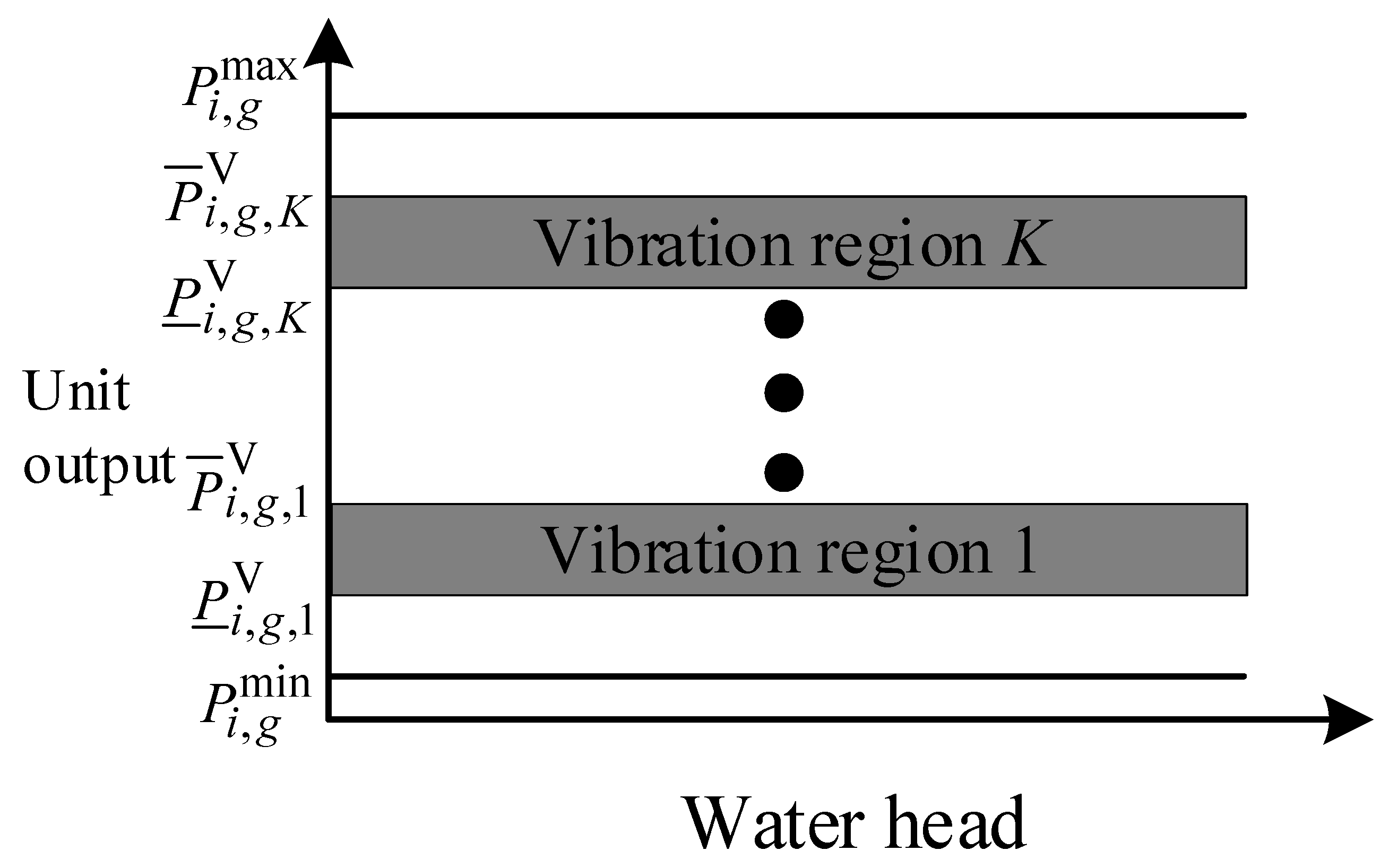

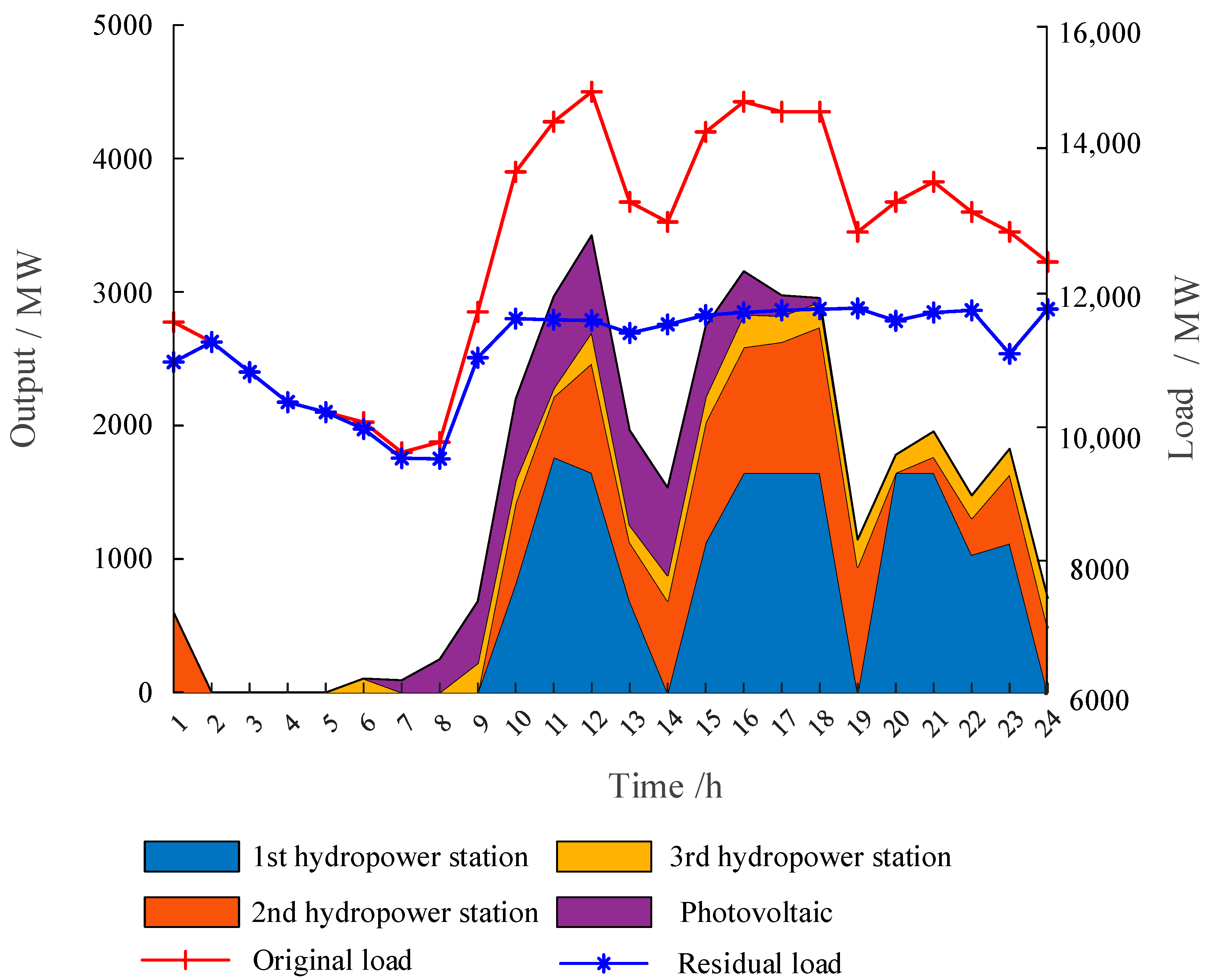
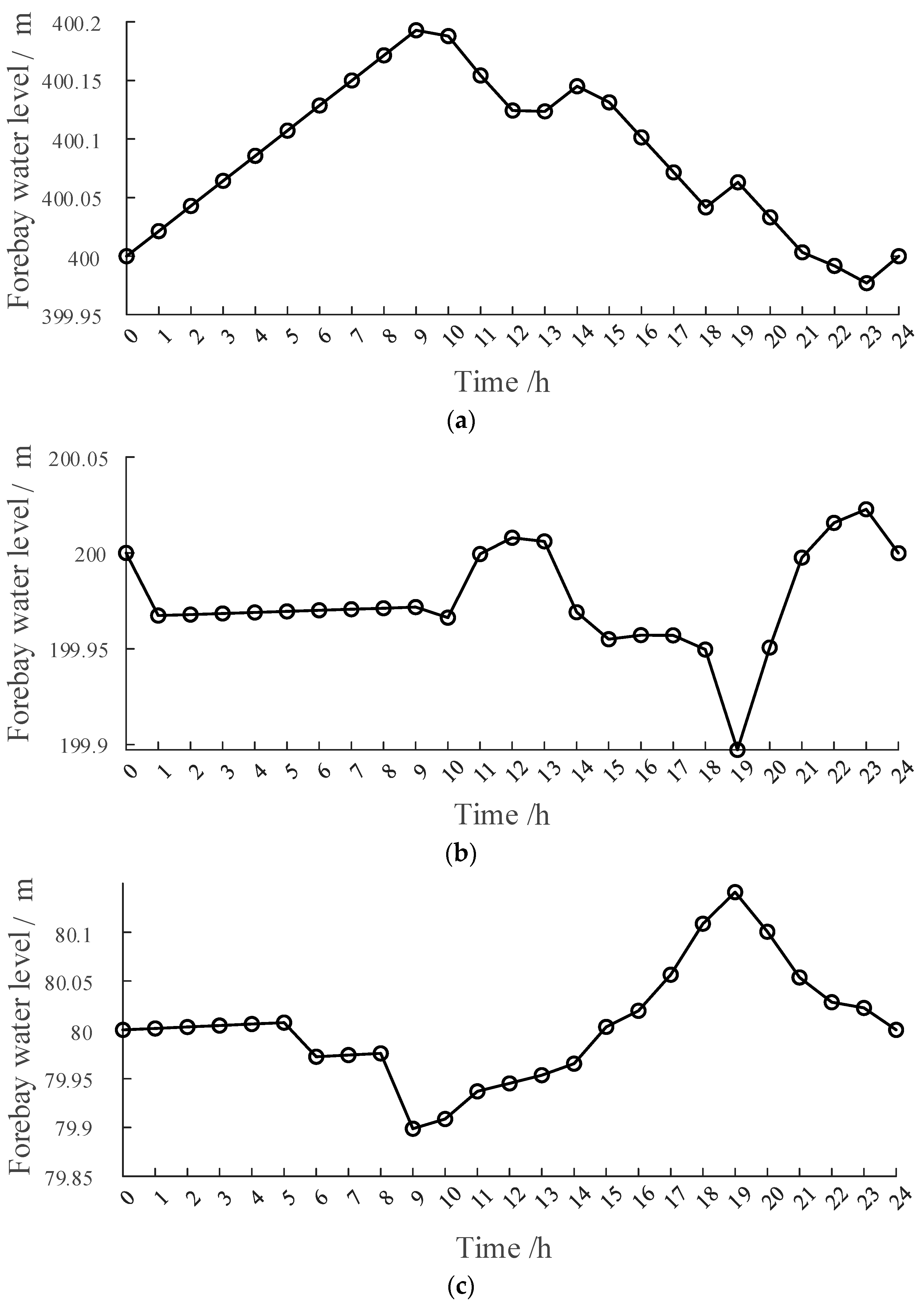
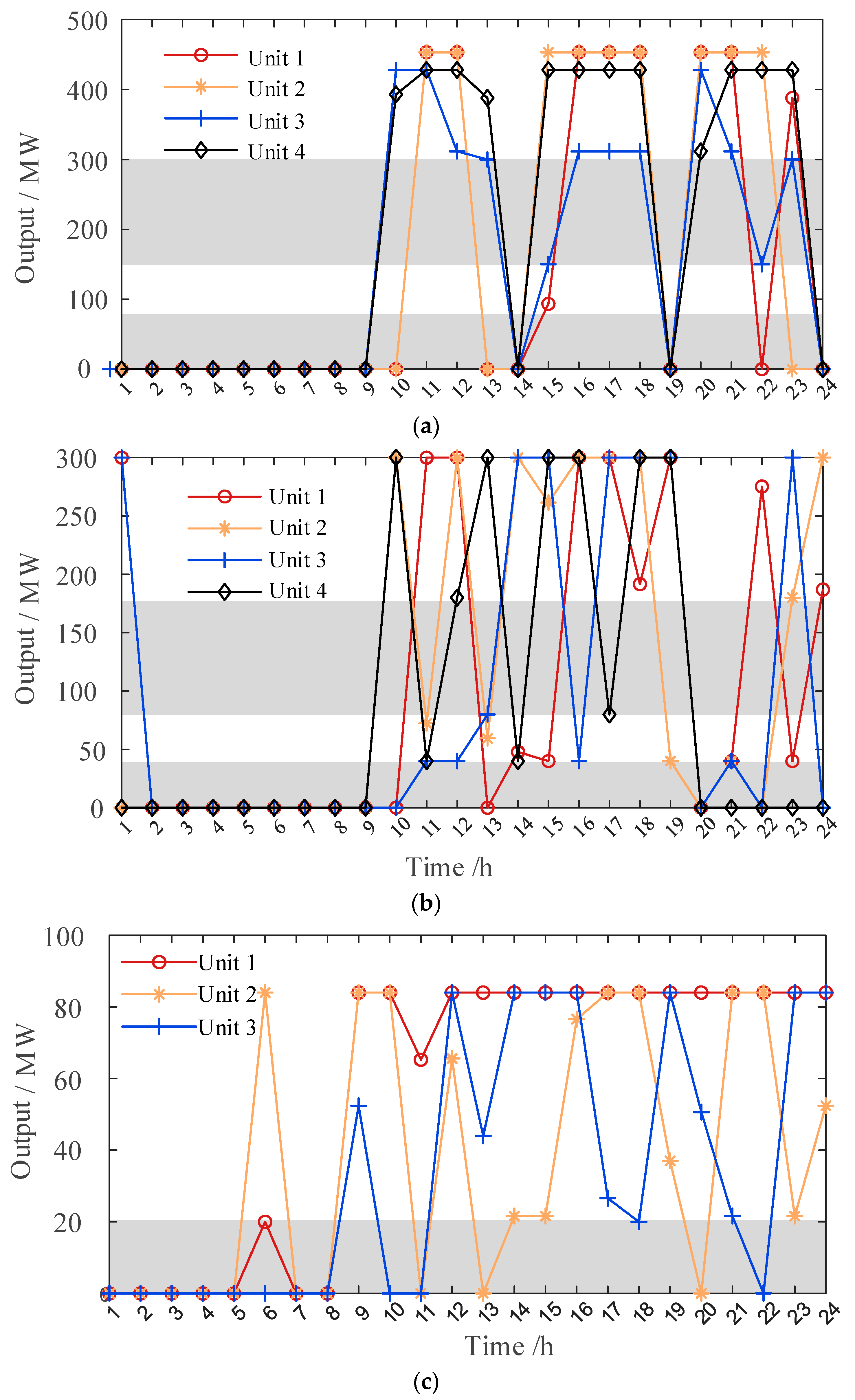
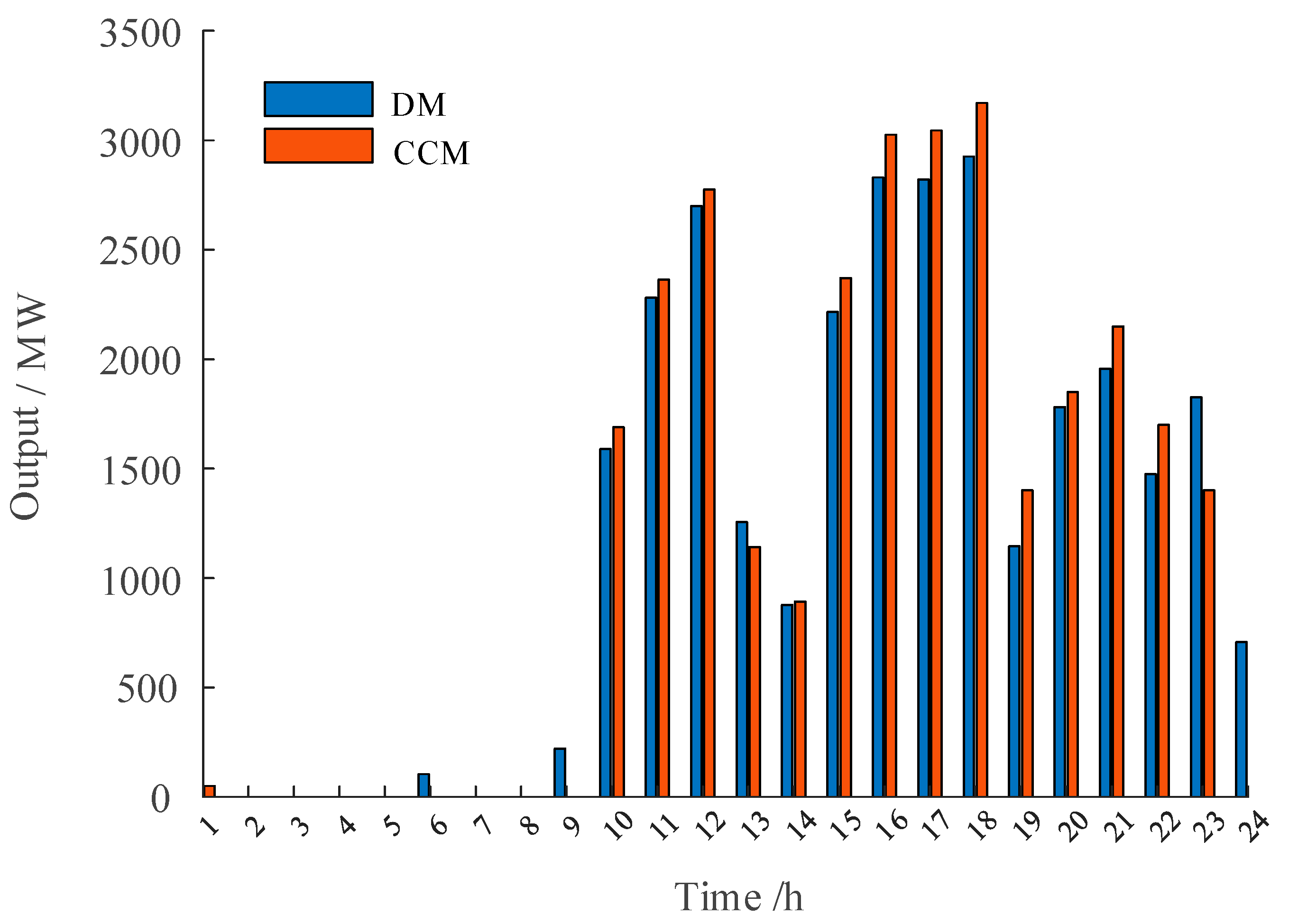
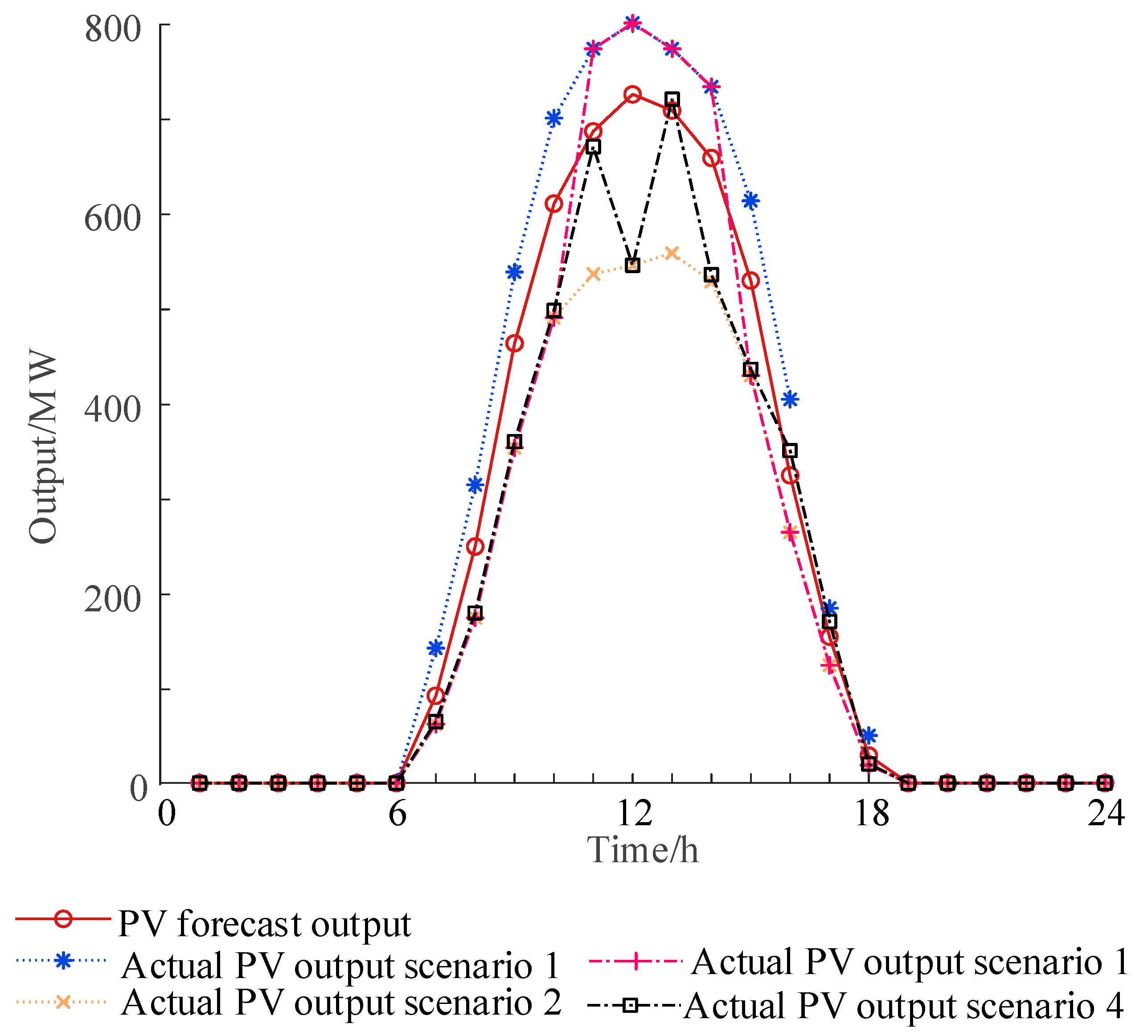
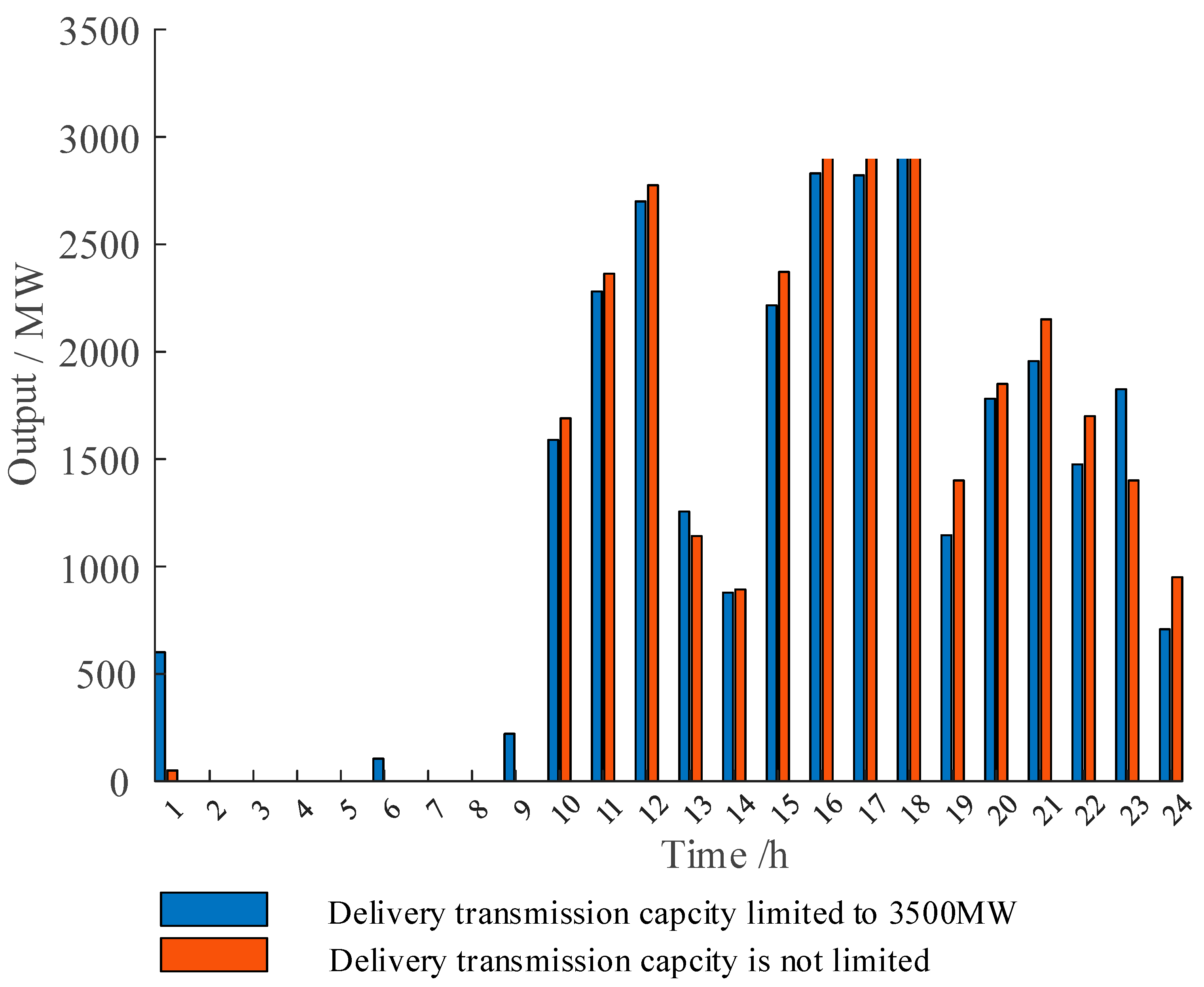
| Hydropower Station | Installed Capacity/MW | Unit Vibration Zone/MW | Maximum Power Flow per Unit/(m3·s−1) |
|---|---|---|---|
| 1 | 4 × 460 | 0~80, 150~300 | 257 |
| 2 | 4 × 300 | 0~40, 80~180 | 328 |
| Receiving-End Power Grids’ Load | Peak Value/MW | Valley Value/MW | Peak–Valley Difference/MW | Variance/MW2 |
|---|---|---|---|---|
| Original load | 15,000 | 9600 | 5400 | 3,022,344 |
| Residual load | 11,755 | 9436 | 2319 | 556,200 |
| Model | PV Output Scenario | Peak–Valley Difference/MW | PV Curtailment/(MW·h) |
|---|---|---|---|
| CCM | Predicted output | 2074 | 0 |
| Scenario 1 | 2064 | ||
| Scenario 2 | 2217 | ||
| Scenario 3 | 2217 | ||
| Scenario 4 | 2219 | ||
| DM | Predicted output | 1999 | 0 |
| Scenario 1 | 2064 | 75 | |
| Scenario 2 | 2142 | 0 | |
| Scenario 3 | 2082 | 75 | |
| Scenario 4 | 2145 | 0 |
| Delivery Transmission Line Capacity/MW | Peak Value/MW | Valley Value/MW | Difference between Peak and Valley/MW |
|---|---|---|---|
| 3000 | 12,255 | 9436 | 2819 |
| 3300 | 11,955 | 9436 | 2519 |
| 3500 | 11,755 | 9436 | 2319 |
| 4000 | 11,554 | 9436 | 2118 |
Disclaimer/Publisher’s Note: The statements, opinions and data contained in all publications are solely those of the individual author(s) and contributor(s) and not of MDPI and/or the editor(s). MDPI and/or the editor(s) disclaim responsibility for any injury to people or property resulting from any ideas, methods, instructions or products referred to in the content. |
© 2023 by the authors. Licensee MDPI, Basel, Switzerland. This article is an open access article distributed under the terms and conditions of the Creative Commons Attribution (CC BY) license (https://creativecommons.org/licenses/by/4.0/).
Share and Cite
Li, Y.; Wu, F.; Song, X.; Shi, L.; Lin, K.; Hong, F. Data-Driven Chance-Constrained Schedule Optimization of Cascaded Hydropower and Photovoltaic Complementary Generation Systems for Shaving Peak Loads. Sustainability 2023, 15, 16916. https://doi.org/10.3390/su152416916
Li Y, Wu F, Song X, Shi L, Lin K, Hong F. Data-Driven Chance-Constrained Schedule Optimization of Cascaded Hydropower and Photovoltaic Complementary Generation Systems for Shaving Peak Loads. Sustainability. 2023; 15(24):16916. https://doi.org/10.3390/su152416916
Chicago/Turabian StyleLi, Yang, Feng Wu, Xudong Song, Linjun Shi, Keman Lin, and Feilong Hong. 2023. "Data-Driven Chance-Constrained Schedule Optimization of Cascaded Hydropower and Photovoltaic Complementary Generation Systems for Shaving Peak Loads" Sustainability 15, no. 24: 16916. https://doi.org/10.3390/su152416916
APA StyleLi, Y., Wu, F., Song, X., Shi, L., Lin, K., & Hong, F. (2023). Data-Driven Chance-Constrained Schedule Optimization of Cascaded Hydropower and Photovoltaic Complementary Generation Systems for Shaving Peak Loads. Sustainability, 15(24), 16916. https://doi.org/10.3390/su152416916






